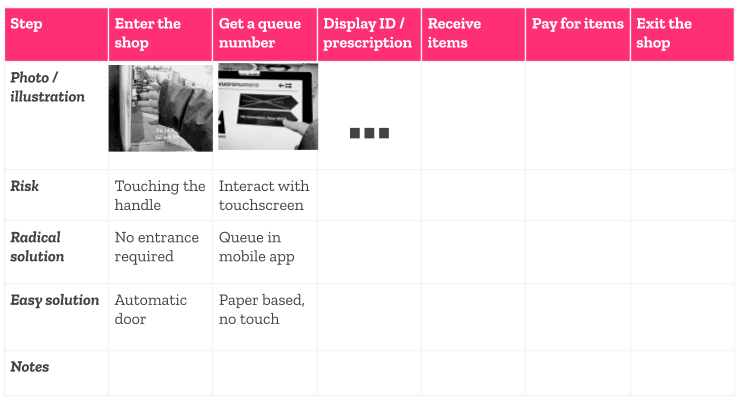
How service design can slow the spread of viral disease
Service design has a bad reputation for being too slow, expensive, and abstract for quick wins. But that's not always the case. Here’s a drugstore case study giving a quick and concrete example of how customer journeys can help improve hygiene with a few simple and radical ideas.
Service design has a bad reputation for being too slow, expensive, and abstract for quick wins. But that’s not always the case. Here’s a drugstore case study giving a quick and concrete example of how customer journeys can help improve hygiene with a few simple and radical ideas.
Viral and bacterial infections can spread through touch. An infected person coughs and small particles of mucus containing virus land on surfaces. A healthy person touches the surface and scratches their eye with the same hand. Congrats virus, you just found a new home!
One way to mitigate the viral threat is to reduce personal contact to a minimum. We have seen this already: HSL has started to prefer mobile tickets, stores installed plexiglass at their counters, and Wolt started leaving food outside people’s doors.
The present crisis reminds us that these solutions may not be temporary. Instead, they might reflect a permanent change in the way we protect ourselves. The enormous impact of the pandemic hopefully ensures that in the future we will make hygiene a priority in many ways that previously we couldn’t even imagine.

Customer Journeys for mitigating the spread of viral infections. Download as PDF.
Here’s our three-step method for doing this in the context of traditional services.
Observation-based customer journeys for improving hygiene
This exercise is best suited for clear-cut transactions, such as visiting a pharmacy to fetch a prescription drug. Here’s how it goes:
1. Observe and document the journey
2. Draw the customer journey on paper, identifying all risks
3. Brainstorm for interventions to mitigate risks
Step 1: Understanding through observation
Gaining a perfect understanding of how every single person completes their journey is possible only in theory. Theoretical insight must be coupled with real-world observations to catch the all-important details, the things your imagination could miss or the conditions which you thought might be possible but never actually happen in real life.
It is best to observe someone else. Trying to observe your own actions in real-life situations is difficult even if you use a head or body-mounted action cam to record your moves. Following another person who has had some time to get used to the idea of being monitored is more effective. Agree on the monitoring in advance. It is best if your subject has some experience with the task, so they will be able to exhibit routine behaviors that usually go unnoticed.
You can ask the other person to slow down or pause if you are recording stil photos instead of video, although the latter is more informative.
Step 2: Create the customer journey
There are hundreds of variations to customer journeys. Each variation has different stages (columns) and points of interest (rows). I suggest you break down the journey and the steps that usually involve a potential risk. Mark the risks associated with each step on the first row.
The risk assessment should be both descriptive as well as quantitative. At minimum, try to identify the severity of different risks on the journey or use a simple scale such as minor, moderate, high, and very high.
Step 3: Generate solutions
Once you have mapped the journey and identified the risky steps, you can start solving them. I suggest offering both easily achievable and radically different solutions. Remember that there is always a choice, such as skipping some steps along the way – or even abandoning the whole process. These radical ideas may not always be doable in a short time frame, however, which is why you should also offer a simple option.
It could be a good idea to do a quick brainstorming session with a handful of people. Don’t spend too much time on any single step. Start by working independently and only present the ideas to the whole group after that. Remote work and chats are an excellent way to generate ideas.
Once you have generated them, it is time to decide which ideas to execute. The following questions can help with ranking the ideas:
1. Implementation time
2. Degree of risk reduction
3. Implementation cost
If the scoring doesn’t immediately reveal the right solution, democratic voting can be helpful. Voting is also useful because it can expose unspoken fears or beliefs about certain ideas – revealing that people are secretly against or in favor of something, but just didn’t bring it up for some reason.
How it goes in practice
First choose the customer journey you want to track, preferably based on data about the most typical ones in your business. This can be done by reviewing transactions and using your own understanding of customer behavior to judge which ones involve the most evident risks.
Find a partner to help with documenting the journey. One of you must play the role of the typical customer, while the other shoots the video or takes photos. Time the operation for minimal interference with normal customers, outside regular operating hours if possible. It’s also safer that way!

Here’s an example of how the template can be used.
When you’re done, analyze the video and create a draft of the journey. You can probably recognize the likely risks from the recording alone. If possible, try to separate the different stages of the journey, but don’t be afraid to add stages that don’t seem to pose any current risks. For instance, one step could be finding your way to the prescription counter in a big store, which is usually done by following signs, but might also involve talking to a clerk.
Do the ideas next. Identifying risks earlier on helps a lot in coming up with potential solutions. I ran this exercise for a drug store with a scenario involving picking up prescription medication. I identified four steps that involved risks:
1. Opening and closing the front door by hand
2. Getting a queue number from a touchscreen terminal
3. Presenting your ID to the pharmacist
4. Making the payment
Some solutions present themselves immediately. The door could open automatically or have a button that doesn’t have to be touched. Getting a queue number could work in a similar way. The touchscreen is not really used for anything else. An easy alternative could be to replace the terminal with a physical queue system that respects safe distances between customers. Customers can scan the barcodes of their IDs themselves and show the ID through a glass. Putting a glass between the pharmacist and customer would make the interaction a bit safer for both. Contactless payment should be preferred at the point of sale.
A more radical solution that still involves a physical drug store would be having a drive-in option for pick-ups, with orders, payment, and queueing handled in a mobile app.
Go and try it yourself! This is a light-weight, quick and efficient solution and I’m confident you can discover ways to improve your service hygiene with it.



